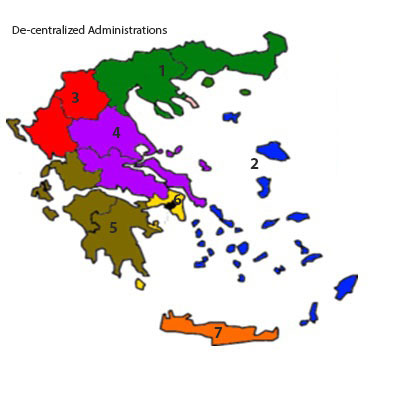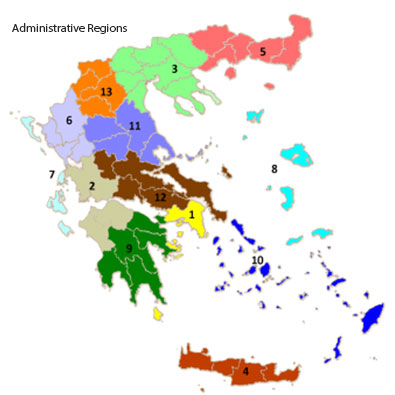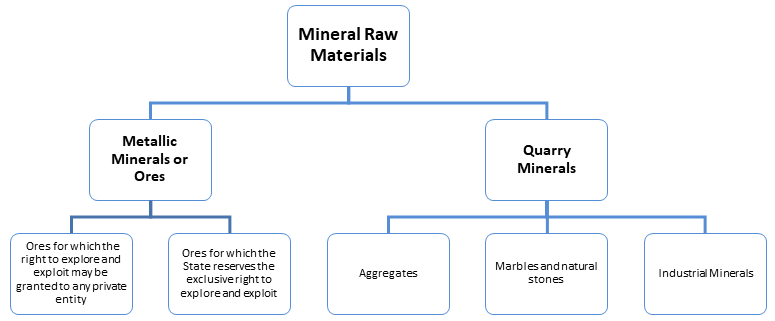Quarry Minerals
Quarry Minerals are legally classified into three subcategories: Industrial minerals, marbles & natural stones, and aggregates. Exploration and exploitation of Quarry Minerals are regulated by the Quarrying Law (L.4512/2018 Part B Exploration and Exploitation of quarry minerals and other provisions, Art. 43-72). Due to the localized nature of aggregates extraction, consumption and uses, detailed reference to aggregate resources exceeds the scope of this Guide and will not be performed. Thus, unless otherwise specified, whenever the term Quarry Minerals is used in this Guide it is meant industrial minerals, marbles & natural stones.
What is the Quarry Minerals’ Ownership Right?
The right to explore and exploit Quarry Minerals, located either on surface or underground, is called Quarry Minerals’ Ownership Right. This right belongs to the owner of the land in which these minerals occur, or to any third party the landowner has lawfully ceded this right. The holder of this right is entitled also to exploit all produced by-products and to utilize the extractive wastes stemming from the extraction and processing of Quarry Minerals (Art.44, paragraph 1 of L.4512/2018).
The procedures applied, for the granting of Quarry Minerals’ Ownership Right, depend on the type of land ownership namely private, public, or municipal.
Procedures to obtain the Quarry Minerals’ Ownership Right on private land
The exploration and exploitation right on private land, belongs to landowner or to any third party the landowner has lawfully ceded this right. The latter case shall be evidenced by a notarial deed of lease of the land, accompanied by the relevant documentation and certification. Such documentation includes legal title to the land, a certificate of registration from the competent land registrar’s office, a certificate and map from the cadastral office and a recent topographic map of an appropriate scale.
Exploration and exploitation activities for quarry minerals on private land are subject to a simple notification addressed to the De-centralized Administration concerned pursuant to JMD171311/2018. In cases of non-compliance with the requirements of the notification procedure, certain penalties are foreseen and may be applied to the operator, pursuant to Art. 8 of the JMD171311/2018.
Prior to the submission of the notification, the operator should have fulfilled certain obligations as analyzed further in the following steps:
1. Analysis of the successive steps to perform exploration activities on private land
Click here to download a simplified diagram of the procedure.
Obtain the notarial deed of lease of the land, accompanied by the relevant documentation and certification.
Issue a letter of guarantee of unlimited duration for the fulfillment of your environmental restoration obligations. This letter shall amount to €500 per ha of the area of interest. Such a letter is not required when the exploration works foreseen do not constitute significant interventions to the ground (e.g., geophysical, and geochemical surveys, drillholes e.tc.).
Prepare a declaration of conformity with Standard Environmental Commitments according to Annex A of MD46294/2013. Submit it to the concerned De-centralized Administration, accompanied by the letter of guarantee of Step 1.2. The concerned De-centralized Administration will subsequently issue a decision making the operator subject to Standard Environmental Commitments pursuant to L.4014/2011 and according to Annex A of MD46294/2013.
Prepare a declaration of conformity with Standard Technical Commitments according to Annex 1 of L.4512/2018. Submit the declaration to the concerned Mining Inspection Department for its assent. The quantity of the material that may be obtained for research will be reported in this declaration. Said quantity should not exceed 5 m3 per 1ha, while the total excavated volume may not exceed ten times that quantity (Art.50 of L.4512/2018).
Pay a fee of €100 value for the submission of the notification. Submit the notification, according to Annex II of JMD171311/2018, via electronic means, using the Integrated Information System for Performing Activities and Controls (IMS-PAC). If IMS-PAC is not yet in place, submit the notification to the De-centralized Administration. Keep the receipt of the notification’s submission safe.
Create a dossier and keep the dossier complete and up to date for future audits and inspections.
1. Simplified diagram – Exploration for Quarry Minerals on private land
Obtain the notarial deed of lease of the land (Step 1.1)
- Legal title to the land, with the land registrar’s office certificate
- Certificate and map from the cadastral office
- Recent topographic map
Decision for subjection to Standard Environmental Commitments (Steps 1.2 & 1.3)
- Issue a letter of guarantee of €500 per ha in case of extended interventions
- Prepare a declaration of conformity with Standard Environmental Commitments
- Submit the letter and declaration to the concerned De-centralized Administration which will issue the decision for subjection
Obtain the assent of the Mining Inspection Department (Step 1.4)
- Prepare a declaration of conformity with Standard Technical Commitments
- Submit it to the Mining Inspection Department concerned
Notify your activity (Step 1.5)
- Pay a fee of €100
- Submit the notification electronically or to the De-centralized Administration
Dossier (Step 1.6)
- Create and keep a complete dossier of documents
2. Analysis of the successive steps to perform exploitation activities on private land
Click here to download a simplified diagram of the procedure.
Obtain the notarial deed of lease of the land, accompanied by the relevant documentation and certification. The deed shall have an initial duration of 20 years which may be extended for another 20 years unilaterally at the will of the leaseholder. The leaseholder shall pay an annual lease fee to the landowner comprising a fixed fee and a pro-rata fee, pursuant to Art. 45 of L.4512/2018. The duration of the notarial deed of lease, provided certain conditions are fulfilled, may be extended beyond 40 years, but under no circumstances may exceed a total of 70 years from the start of the lease (Art. 45 paragraph 3 of L.4512/2018).
Conduct an Environmental Impacts Assessment Study (EIA) and submit it to the competent authority (i.e., YPEN for A1 subcategory and the De-centralized Administration for A2 subcategory). Obtain the decision on the approval of environmental conditions for the requested activity (i.e., AEPO). This decision is either issued by YPEN or by the concerned De-centralized Administration, in accordance with the MD37674/2016.
Prepare the Technical Study of exploitation in accordance with the KMLE and submit it to YPEN, accompanied by the notarial deed of lease of the land and the AEPO. Obtain approval of the submitted technical study. Pay a fee for the approval ranging from a minimum amount of €300 to a maximum amount of €6.000. This fee is calculated as a 2‰ percentage on the budget of the investment foreseen.
Obtain approval by the Minister for Culture and Sports, in accordance with Art.10 of L.3028/2002. Skip this step if this approval has been granted at a previous stage (i.e., step 2.2).
Issue a letter of guarantee of unlimited duration for the fulfillment of your environmental restoration obligations. The value of the letter shall be calculated according to the amount of environmental restoration costs, indicated in the decision on the approval of environmental conditions. Submit the letter of guarantee to the concerned De-centralized Administration.
Pay a fee of €200 value for the submission of the notification. Submit the notification, according to Annex II of JMD171311/2018, via electronic means, using the Integrated Information System for Performing Activities and Controls (IMS-PAC). If IMS-PAC is not yet in place, submit the notification to the concerned De-centralized Administration. Keep the receipt of the notification’s submission safe.
Create a dossier and keep the dossier complete and up to date for future audits and inspections.
Procedures to obtain the Quarry Minerals’ Ownership Right on public or municipal land
The exploration and exploitation right of Quarry Minerals located on public land or municipal land belongs respectively to the Greek State or the concerned Municipality. The Greek State also owns the right to explore and exploit Quarry Minerals located on public land designated as forest or public grassland.
The coordinator of the concerned De-centralized Administration or the head of the concerned Municipality conduct the leasing of public or municipal land respectively either by direct lease agreements or through a public sealed bid auction (pursuant to Art. 53 and 54 of L.4512/2018). Lease contracts regarding exploitation by direct lease agreements shall apply only if the applicant has already lawfully obtained the right to perform exploration activities in the specific area.
Lease contracts regarding exploitation are valid for at least 20 years which may be extended for an additional 20-year period, provided a mutual agreement between the two parts has been reached. The duration of the notarial deed of lease, may be extended beyond 40 years, provided certain conditions are fulfilled, but under no circumstances may exceed a total of 70 years from the start of the lease (Art. 45 paragraph 3 of L.4512/2018).
Exploration and exploitation activities on public or municipal land are subject to approval requirements. As provisioned, the lease contract drawn up in accordance with Art. 45, 53 and 54 of L.4512/2018 regarding exploitation, shall serve as approval.
2. Simplified diagram – Exploration for Quarry Minerals on private land
Obtain the notarial deed of lease of the land (Step 2.1)
- Legal title to the land with the land registrar’s office certificate
- Certificate and map from the cadastral office
- Recent topographic map
- Deed duration: min 20 and max 70 years
- Lease fees: a fixed fee and a pro-rata fee
Obtain the AEPO (Steps 2.2)
- Conduct an Environmental Impacts Assessment Study (EIA)
- Submit the EIA Study to the competent authority that shall issue the AEPO
Obtain approval of the Technical Study (Step 2.3)
- Prepare the Technical Study in accordance with the KMLE
- Submit the Study to YPEN together with the notarial deed and the AEPO
- Pay 2‰ on the investment budget as fee for the approval (min €300 max €6.000)
Issue and submit a letter of guarantee (Step 2.4)
- Issue a letter of guarantee covering your environmental restoration obligations
- Submit the letter to the De-centralized Administration
Obtain approval of the Minister for Culture and Sports (Step 2.5)
Issue and submit a letter of guarantee (Step 2.6)
- Pay a fee of €200
- Submit the notification electronically or to the De-centralized Administration
Create and keep a complete dossier of documents (Step 2.7)
3. Analysis of the successive steps to perform exploration activities on public or municipal land
Click here to download a simplified diagram of the procedure.
Apply for the approval of exploration via electronic means using the Integrated Information System for Performing Activities and Controls (IMS-PAC). If IMS-PAC is not yet in place, apply to the concerned De-centralized Administration. The application is accompanied by a topographic map of 1:5000 scale and a fee of €3.000 value. Exploration work in public and municipal areas shall be carried out in a single (unified) designated area of up to 30ha. The De-centralized Administration shall examine the application if certain conditions are met (pursuant to Art.3, paragraph 7 of JMD171313/2018). If the application is accepted the applicant proceeds to the next steps.
In the case of municipal land, the assent of the concerned municipal council is requested.
Issue a letter of guarantee of unlimited duration, amounting to €500 per ha, for the fulfillment of your environmental restoration obligations. Such a letter is not required when the exploration works foreseen do not constitute significant interventions to the ground (e.g., geophysical, and geochemical surveys, drillholes e.tc.).
Submit to the concerned De-centralized Administration a declaration of subjection to Standard Environmental Commitments, according to
Annex A of MD46294/2013, accompanied by all the necessary documentation and the letter of guarantee referred to in Step 3.3 (pursuant to L.4014/2011 and MD46294/2013).
Prepare a declaration of conformity with Standard Technical Commitments according to
Annex 1 of L.4512/2018. Submit the declaration to the competent Mining Inspection Department for its assent. This assent should be duly submitted to the concerned De-centralized Administration. The quantity of the material that may be obtained for research will be reported in this declaration. Said quantity should not exceed 5 m
3 per 1ha, while the total excavated volume may not exceed ten times that quantity (Art.50 of L.4512/2018).
The concerned De-centralized Administration examines all submitted documents and grants its approval within 20 days (provided all submitted documents are complete). The applicant pays a €400 fee for the approval. Approval is granted on a ‘first come first served’ basis, as evidenced by the reference no of the submitted original application in step 3.1 and it is valid for 2 years and for a single (undivided) designated area of up to 30ha.
3. Simplified diagram – Exploration for Quarry Minerals on public or municipal land
Submit application for approval of exploration (Step 3.1)
- Pay a fee of €3.000 to the De-centralized Administration
- Submit a topographic map of 1:5000 scale for a unified single area ≤ 30ha
Obtain the assent of the concerned municipal council (only for municipal land) (Steps 3.2)
Decision for subjection to Standard Environmental Commitments (Step 3.3 & 3.4)
- Issue a letter of guarantee of €500 per ha in case of extended interventions
- Prepare a declaration of conformity with Standard Environmental Commitments
- Submit the letter and declaration to the concerned De-centralized Administration which will issue the decision for subjection
Obtain the assent of the Mining Inspection Department (Step 3.5)
- Prepare a declaration of conformity with Standard Technical Commitments
- Submit it to the Mining Inspection Department concerned
Granting of the approval for exploration (Step 3.6)
- Pay a fee of €400 to the De-centralized Administration
- Approval is granted within 20 days following acceptance of documents
- Approval is valid for 2 years
4. Analysis of the successive steps to conduct exploitation activities on public or municipal land performed by direct lease agreement
Click here to download a simplified diagram of the procedure.
Compose an Environmental Impacts Assessment Study (EIA) and submit it to the competent authority (i.e., YPEN for A1 subcategory and the De-centralized Administration for A2 subcategory). Reserve the submission’s receipt.
Apply for a direct lease agreement, via electronic means, using the Integrated Information System for Performing Activities and Controls (IMS-PAC). If IMS-PAC is not yet in place, submit the application to the concerned De-centralized Administration (public land) or the concerned Municipality (municipal land), at the latest within six (6) months from the expiry date of the exploration permit, accompanied by the receipt of EIA submission in Step 4.1.
Obtain the AEPO issued either by YPEN or by the De-centralized Administration concerned, based on the EIA study submitted in Step 4.1. Submit the AEPO to the concerned De-centralized Administration (public land) or the concerned Municipality (municipal land).
Prepare the exploitation Technical Study in accordance with the KMLE and submit it to YPEN, accompanied by the AEPO. Obtain its approval and submit it either to the concerned De-centralized Administration (public land) or the concerned Municipality (municipal land). Pay a fee for the approval ranging from a minimum amount of €300 to a maximum amount of €6.000. This fee is calculated as a 2‰ percentage on the budget of the investment foreseen.
Issue a letter of guarantee, of unlimited duration, for the fulfillment of the environmental restoration obligations. Its value shall be based on the amount of environmental restoration costs indicated in the AEPO. Submit this letter of guarantee to either the concerned De-centralized Administration (public land) or the concerned Municipality (municipal land).
Issue a letter of guarantee for proper performance of the terms and conditions of the lease contract and submit it to the concerned De-centralized Administration.
The coordinator of the concerned De-centralized Administration, in the case of public land or the mayor in the case of municipal land shall, within 20 days and after payment of a €600 fee, issue a decision approving the direct lease agreement of the respective public or municipal land setting out the financial conditions of the lease contract. They shall invite within 20 days the interested party to sign the contract. Lease contracts have a duration of min 20 years and may reach a max of 70 years provided certain conditions are fulfilled (according to Art. 45, paragraph 3 of L.4512/2018).
Prior to the commencement of any operations on public or municipal land and within one year from the signing of the respective contracts, the lessee should notify YPEN, and the Archaeological service concerned about the start of operations.
4. Simplified diagram – Exploitation of Quarry Minerals on public or municipal land by direct lease agreement
Conduct an EIA Study and submit it to the competent (Step 4.1)
Submit application for direct lease agreement (Steps 4.2)
- Within 6 months from the expiry date of the exploration permit
- Attach receipt of the EIA submission to application
Obtain the AEPO (Step 4.3)
Obtain approval of the Technical Study (Step 4.4)
- Prepare the Technical Study in accordance with the KMLE
- Submit the Study to YPEN together with the AEPO
- Pay 2‰ on the investment budget as fee for the approval (min €300 max €6.000)
Issue and submit 2 letters of guarantee (Steps 4.5 & 4.6)
- Issue a letter of guarantee covering your environmental restoration obligations
- Issue a letter of guarantee for proper performance of the terms of the lease contract
- Submit the letters to the authority concerned
Sign the lease contract (Steps 4.7)
- Pay a fee of €600 and submit the receipt to the authority concerned
- Within 20 days, a decision shall be issued approving the direct lease agreement
- Deed duration: min 20 and max 70 years
Notify about commencement of activities within 1 year from the signing of the lease contract (Steps 4.8)


